![]()
![]()
![]()
Use LEFT and RIGHT arrow keys to navigate between flashcards;
Use UP and DOWN arrow keys to flip the card;
H to show hint;
A reads text to speech;
35 Cards in this Set
- Front
- Back
- 3rd side (hint)
|
Anterior cornea: ____wide, ____tall |
11.7 wide, 10.6 tall |
|
|
|
Posterior cornea:__wide, __tall |
11.7 wide, 11.7tall |
|
|
|
Central thickness |
.52 mm |
|
|
|
Limbal thickness |
Avg .67mn |
|
|
|
Central radius of curvature |
Avg. 7.6mm |
|
|
|
The average corneal net power |
Anterior 49 dpt posterior -6 adapters total of 43 dpt |
|
|
|
Microcornea |
7-10mm wide (recall avg width is 11.7) |
|
|
|
Megacornea |
12mm at birth and >13mm in adult |
|
|
|
Transient amplifying cells from limbal stem cell move centripetally into basal layer. complete epithelium turns over every ______days |
7-10 days |
|
|
|
Index of refraction of tear film and thickness |
Thickness 3 µm n= 1.336 |
|
|
|
Corneal epithelium divided into three layers. Starting from the surface, working your way towards the bottom what is the order? |
Surface—>bottom: 5-7 total cell layers 1. Surface squamous cells (2-3 cell layers thick) 2. Wing Cells: (2-3 cell layers thick) 3. Basal cells: (1 cell layer thick) |
|
|
|
How does corneal epi generate itself? |
Basal cells At center mitotically: cells divide both cells rise up At limbus, most generates from here, by stem cells called transient amplifying cells. One Daughter cell stays behind and other centripetally towards central cornea |
|
|
|
Tear film is ____ thick |
3mm |
|
|
|
Index of refraction of tear film |
n=1.33 |
|
|
|
Tear film is a Colloidal mixture (mixture of layers, not really a distinct). What are the 3 layers? From superficial to deep |
LAM: 1. Lipid layer: oily layer produced by sebaceous glands. The meibomian glands are sebaceous glands that undergo holocrine secretion, which means that the entire cell and its contents are released. 2. Aqueous layer: watery layer made by lacrimal glands (main and accessory glands). contains antibacterial factors including immunoglobulins. The aqueous layer also contains soluble mucin that decreases the surface tension, enhances the spread and coherence of the aqueous layer, and contributes to the viscosity of the tear film. Nutrients provided to the avascular cornea by the aqueous layer include inorganic salts, glucose, oxygen, and proteins. 3. Mucins layer: Glycocalyx, surface bound mucins made by epithelial and goblet cells if conjunctiva. The corneal epithelium is hydrophobic, so the hydrophilic layer, created by the mucus, facilitates the spread of the aqueous layer evenly over the ocular surface. The mucus layer is not tightly adhered to the epithelial layer, but rather attaches to the glycocalyx and undergoes free movement across the cornea. This allows the mucus to spread evenly across the cells and prevents damage to the epithelium during blinking |
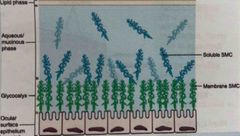
|
|
|
Cornea Surface cells develop_____. List its function |
Microplicae. 1. Increased SA for gas exchange since cornea is a vascular 2. Ridge holds tear film! |
|
|
|
Cornea innervated by |
CN V called trigeminal n. First branch is opthalmic branch |
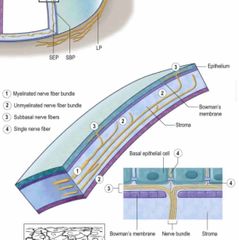
|
|
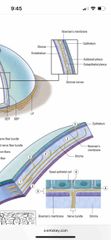
Front (Term) |

❤️
|
|
|
|
Describe the interellular junctions at the cornea. Function and type |
GTHD G: Gap junctions- allows cells to communicate with one another. Composed of connexin proteins. type of focal junction that provides intercellular gated channels. Facilitate electronic and metabolic coupling of cells to coordinate functions. Made of 6 proteins, in a ring, called connexins T: Tight Junctions-Zonulae Occludentes (pl) belt like junctions and ring the entire circumference of the cell sealing the intercellular cleft between the cell and all of its adjoining neighbors (macromolecules -proteins- can’t move through the space between adjacent cells). Made of claudins. tight junctions join together the cytoskeletons of adjacent cells H: Hemi desmosomes-Exclusively at basal surface of stratified. Basal cells are attached to basal lamina by hemi desmosomes D: Desmosomes: macula adherens. Epithelial cell-cell contact is anchored intracellular by tonofibrils. Focal junctions serve as spot welds between cells and as anchor points for attachment of cytoskeleton. help resist sharing forces.found in simple and stratified squamous epithelium. Blister? Desmosomes help keep it together |
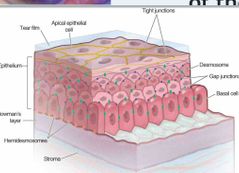
|
|
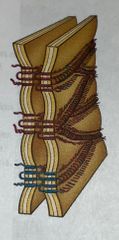
Front (Term) |
Tight junctions (Zonula occludens (singular) (occludentes pl)) Form permeability barrier |
|
|
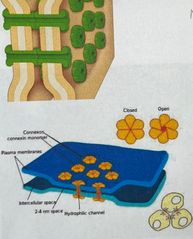
Front (Term) |
Gap junctions |
|
|
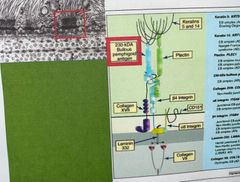
Front (Term) |
Hemi-desmosomes |
|
|
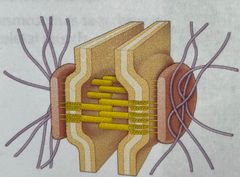
Front (Term) |
Desmosomese (macula adherens) |
|
|
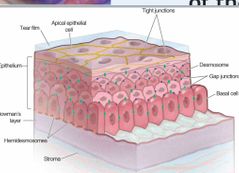
Front (Term) |
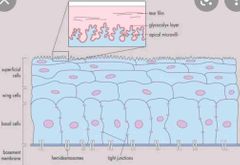
Back (Definition) |
|
|
|
Main cell types in epithelial adhesion Complex |
LIC 1. Laminins: link to and through BM 2. Integrins: w/alpha beta sub units. epi cells joined by integrins. Also join basal layer to BM. (31,64) Alpha 3 w/ beta 1. Alpha 6 w/beta 4 3. Collagen 7: b/w epi and BM. Anchor complex into and through Bowmans layer |
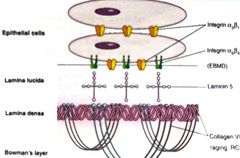
|
|
|
Bowmans layer |
- Remarkably resilient -underneath basement -membrane a cellular condensation of collagen 1&3 smaller diameter than stromal collagen - if cut perpendicular, scar will occur. if removed no scarring -does not reach all the way to limbal junction with sclera. Stops 1mm short if clear white junction called the clear zone |
|
|
|
Stroma |
-Made of dense regular ct - arranged in layers called lamellae, Which run perpendicular to each other, -mostly collagen type 1, Which run perfectly parallel to each other within lamellae. Type one collagen fibers separate by uniform spacing provided by the surrounding proteoglycans and partially hydrated gags. Between lamellae (layers) are fibroblast like cells called keratocytes which are connected by gap junctions |
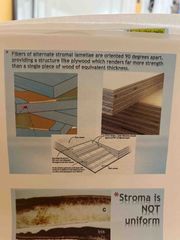
|
|
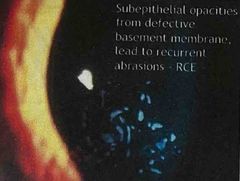
Front (Term) |
Recurrent corneal erosion show increased levels of enzyme matrix metalloproteinases (MMP) that dissolve BM and it’s anchoring components which include integrins laminin and type 7 collagen |
|
|
|
Stromal optical transparency |
According to Maurices theory the light scattering caused by each collagen fiber is canceled by destructive interference from scattering of it’s perfectly spaced neighbors (wavelength/2). Edema alters the spacing which destroys the destructive interference and produces opacity |
|
|
|
Keratocytes (fibroblast) b/w lamellae |
Responsible for Constant breakdown turnover and replenishment of stroma talk to each other by extending processes into other layers so all keratinocytes are linked together by gap junctions so actions are coordinated |
|
|
|
Type 1 collagen of stroma is |
Covered in proteoglycans and gags. Gags hydrate. The key to corneal transparency is to insure that gags don’t fully hydrate so gags are constantly maintained in partial hydration |
|
|
|
Stroma is not uniform. How? |
Higher concentration of Keratocytes and plasma in anterior versus posterior stroma concentrations of various proteoglycans at different concentrations as well Most posterior stromal lamellae, near descemets membrane are structurally more durable than the rest- Dua’s layer |
|
|
|
Descemets membrane |
Begins embryologically as early endothelial BM which exhibit banding by electric microscopy. non-banded descemets is produced after birth and continues to thicken Nodular thickening may occur at its edge called hassal henle bodies Clinically as a true basement membrane its peripheral edge can be seen and is termed schwalbes line |
|
|
|
Corneal Endothelium |
Made of simple cuboidal epithelium but with lose cells as we age and they are not replaced. remaining cells must cover the entire surface of descemets and so they thin and spread looking more Squamous with age If so density drops below 500 to 700 mm² maintaining transparency is difficult Young individuals have small uniform cells at a density of about 3000 to 35,000 mm² |
|
|
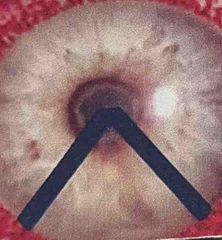
Front (Term) |
Arlt’s triangle. aqueous humor circulates in a convection current driven by temperature difference between the warm Iris and the cooler cornea (which is exposed to air). Aqueous rises posteriorly, close to the iris and then falls along the inside surface of the cornea. Any particulates in aqueous will likely sediment out onto the corner endothelium within Arlt’s triangle distributions of such deposits outside of triangle have diagnostic significance |
|

